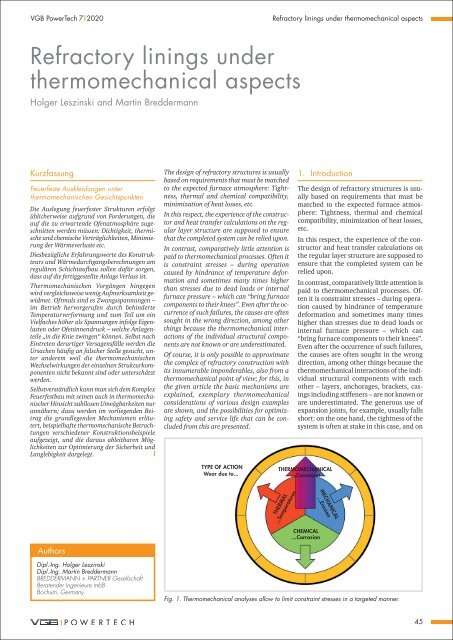VGB POWERTECH 7 (2020) - International Journal for Generation and Storage of Electricity and Heat
VGB PowerTech - International Journal for Generation and Storage of Electricity and Heat. Issue 7 (2020). Technical Journal of the VGB PowerTech Association. Energy is us! Maintenance. Thermal waste utilisation
VGB PowerTech - International Journal for Generation and Storage of Electricity and Heat. Issue 7 (2020).
Technical Journal of the VGB PowerTech Association. Energy is us!
Maintenance. Thermal waste utilisation
Create successful ePaper yourself
Turn your PDF publications into a flip-book with our unique Google optimized e-Paper software.
<strong>VGB</strong> PowerTech 7 l <strong>2020</strong><br />
Refractory linings under thermomechanical aspects<br />
Refractory linings under<br />
thermomechanical aspects<br />
Holger Leszinski <strong>and</strong> Martin Breddermann<br />
Kurzfassung<br />
Feuerfeste Auskleidungen unter<br />
thermomechanischen Gesichtspunkten<br />
Die Auslegung feuerfester Strukturen erfolgt<br />
üblicherweise aufgrund von Forderungen, die<br />
auf die zu erwartende Ofenatmosphäre zugeschnitten<br />
werden müssen: Dichtigkeit, thermische<br />
und chemische Verträglichkeiten, Minimierung<br />
der Wärmeverluste etc.<br />
Diesbezügliche Erfahrungswerte des Konstrukteurs<br />
und Wärmedurchgangsberechnungen am<br />
regulären Schichtaufbau sollen dafür sorgen,<br />
dass auf die fertiggestellte Anlage Verlass ist.<br />
Thermomechanischen Vorgängen hingegen<br />
wird vergleichsweise wenig Aufmerksamkeit gewidmet.<br />
Oftmals sind es Zwangsspannungen –<br />
im Betrieb hervorgerufen durch behinderte<br />
Temperaturver<strong>for</strong>mung und zum Teil um ein<br />
Vielfaches höher als Spannungen infolge Eigenlasten<br />
oder Ofeninnendruck – welche Anlagenteile<br />
„in die Knie zwingen“ können. Selbst nach<br />
Eintreten derartiger Versagensfälle werden die<br />
Ursachen häufig an falscher Stelle gesucht, unter<br />
<strong>and</strong>erem weil die thermomechanischen<br />
Wechselwirkungen der einzelnen Strukturkomponenten<br />
nicht bekannt sind oder unterschätzt<br />
werden.<br />
Selbstverständlich kann man sich dem Komplex<br />
Feuerfestbau mit seinen auch in thermomechanischer<br />
Hinsicht zahllosen Unwägbarkeiten nur<br />
annähern; dazu werden im vorliegenden Beitrag<br />
die grundlegenden Mechanismen erläutert,<br />
beispielhafte thermomechanische Betrachtungen<br />
verschiedener Konstruktionsbeispiele<br />
aufgezeigt, und die daraus ableitbaren Möglichkeiten<br />
zur Optimierung der Sicherheit und<br />
Langlebigkeit dargelegt.<br />
l<br />
The design <strong>of</strong> refractory structures is usually<br />
based on requirements that must be matched<br />
to the expected furnace atmosphere: Tightness,<br />
thermal <strong>and</strong> chemical compatibility,<br />
minimization <strong>of</strong> heat losses, etc.<br />
In this respect, the experience <strong>of</strong> the constructor<br />
<strong>and</strong> heat transfer calculations on the regular<br />
layer structure are supposed to ensure<br />
that the completed system can be relied upon.<br />
In contrast, comparatively little attention is<br />
paid to thermomechanical processes. Often it<br />
is constraint stresses – during operation<br />
caused by hindrance <strong>of</strong> temperature de<strong>for</strong>mation<br />
<strong>and</strong> sometimes many times higher<br />
than stresses due to dead loads or internal<br />
furnace pressure – which can “bring furnace<br />
components to their knees”. Even after the occurrence<br />
<strong>of</strong> such failures, the causes are <strong>of</strong>ten<br />
sought in the wrong direction, among other<br />
things because the thermomechanical interactions<br />
<strong>of</strong> the individual structural components<br />
are not known or are underestimated.<br />
Of course, it is only possible to approximate<br />
the complex <strong>of</strong> refractory construction with<br />
its innumerable imponderables, also from a<br />
thermomechanical point <strong>of</strong> view; <strong>for</strong> this, in<br />
the given article the basic mechanisms are<br />
explained, exemplary thermomechanical<br />
considerations <strong>of</strong> various design examples<br />
are shown, <strong>and</strong> the possibilities <strong>for</strong> optimizing<br />
safety <strong>and</strong> service life that can be concluded<br />
from this are presented.<br />
1. Introduction<br />
The design <strong>of</strong> refractory structures is usually<br />
based on requirements that must be<br />
matched to the expected furnace atmosphere:<br />
Tightness, thermal <strong>and</strong> chemical<br />
compatibility, minimization <strong>of</strong> heat losses,<br />
etc.<br />
In this respect, the experience <strong>of</strong> the constructor<br />
<strong>and</strong> heat transfer calculations on<br />
the regular layer structure are supposed to<br />
ensure that the completed system can be<br />
relied upon.<br />
In contrast, comparatively little attention is<br />
paid to thermomechanical processes. Often<br />
it is constraint stresses – during operation<br />
caused by hindrance <strong>of</strong> temperature<br />
de<strong>for</strong>mation <strong>and</strong> sometimes many times<br />
higher than stresses due to dead loads or<br />
internal furnace pressure – which can<br />
“bring furnace components to their knees”.<br />
Even after the occurrence <strong>of</strong> such failures,<br />
the causes are <strong>of</strong>ten sought in the wrong<br />
direction, among other things because the<br />
thermomechanical interactions <strong>of</strong> the individual<br />
structural components with each<br />
other – layers, anchorages, brackets, casings<br />
including stiffeners – are not known or<br />
are underestimated. The generous use <strong>of</strong><br />
expansion joints, <strong>for</strong> example, usually falls<br />
short: on the one h<strong>and</strong>, the tightness <strong>of</strong> the<br />
system is <strong>of</strong>ten at stake in this case, <strong>and</strong> on<br />
TYPE OF ACTION<br />
Wear due to...<br />
THERMOMECHANICAL<br />
...Constraint<br />
THERMAL<br />
...Temperatures<br />
MECHANICAL<br />
...Erosion<br />
CHEMICAL<br />
...Corrosion<br />
Authors<br />
Dipl.-Ing. Holger Leszinski<br />
Dipl.-Ing. Martin Breddermann<br />
BREDDERMANN + PARTNER Gesellschaft<br />
Beratender Ingenieure mbB<br />
Bochum, Germany<br />
Fig. 1. Thermomechanical analyses allow to limit constraint stresses in a targeted manner.<br />
45


















